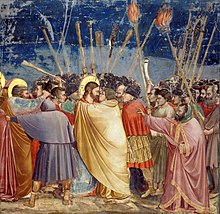
| Events in the |
| Life of Jesus according to the canonical gospels |
|---|
 |
|
Portals: |
The kiss of Judas, also known as the Betrayal of Christ, is the act with which Judas identified Jesus to the multitude with swords and clubs who had come from the chief priests and elders of the people to arrest him, according to the Synoptic Gospels. The kiss is given by Judas in the Garden of Gethsemane after the Last Supper and leads directly to the arrest of Jesus by the police force of the Sanhedrin.
Within the life of Jesus in the New Testament, the events of his identification to hostile forces and subsequent execution are directly foreshadowed both when Jesus predicts his betrayal and Jesus predicts his death.[1]
More broadly, a Judas kiss may refer to "an act appearing to be an act of friendship, which is in fact harmful to the recipient."[2]
In Christianity, the betrayal of Jesus is mourned on Spy Wednesday (Holy Wednesday) of Holy Week.[3][4]
- ^ Graham, Natalie (2011). "Judas Kiss". New England Review (1990-). 32 (2): 88. JSTOR 23053401. Archived from the original on 2024-02-22. Retrieved 2024-02-22.
- ^ "Judas kiss". TheFreeDictionary.com. Archived from the original on 2017-12-07. Retrieved 2010-11-20.
- ^ Cooper, J.HB. (23 October 2013). Dictionary of Christianity. Routledge. p. 124. ISBN 9781134265466.
Holy Week. The last week in LENT. It begins on PALM SUNDAY; the fourth day is called SPY WEDNESDAY; the fifth is MAUNDY THURSDAY or HOLY THURSDAY; the sixth is GOOD FRIDAY; and the last 'Holy Saturday', or the 'Great Sabbath'.
- ^ Brewer, Ebenezer Cobham (1896). The Historic Notebook: With an Appendix of Battles. J. B. Lippincott. p. 669.
The last seven days of this period constitute Holy Week. The first day of Holy Week is Palm Sunday, the fourth day is Spy Wednesday, the fifth Maundy Thursday or Holy Thursday, the sixth Good Friday or Holy Friday, and the last Holy Saturday or the Great Sabbath in Eastern Rite traditions.